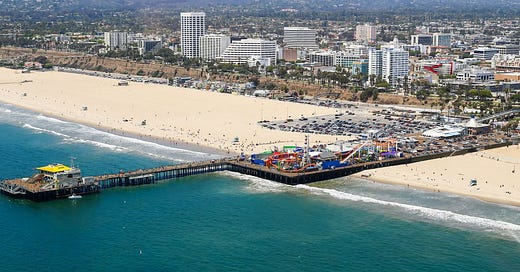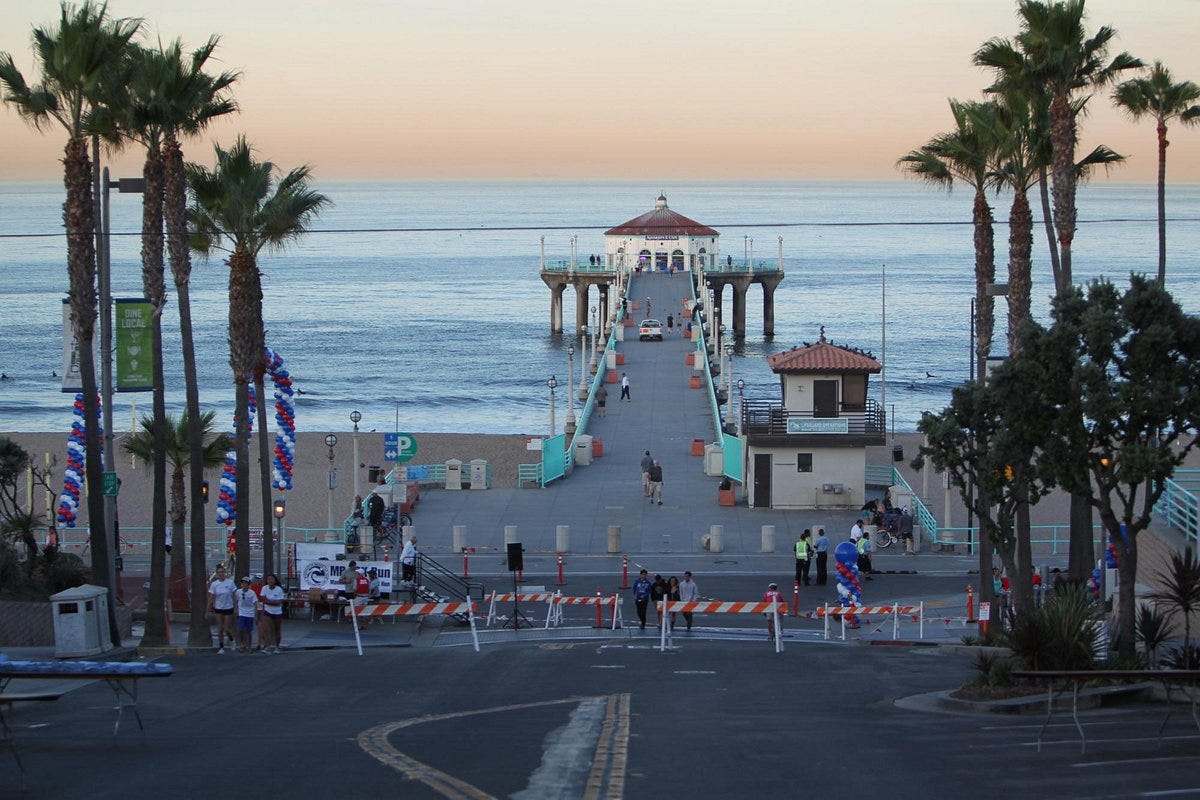The Lure Of The Edge Town
People like hanging out on the edge of something compelling, like an ocean. But how can we make sure "edge towns" are both sustainable and affordable?
I have lived most of my life in what you might call “Edge Towns” – towns on the edge of something. Living in San Diego today, I walk down the street to San Diego Bay, realizing that there is only two thin strips of land in front of me separating me from the Pacific Ocean (Coronado Island and Point Loma) – and behind me lies almost 3,000 miles of land back to Savannah, which is at about the same latitude.
My adopted hometown of Ventura
This is what urban designers call an “edge” — a transition between, you might say, something and nothing. Urban designers think constantly about things like edges, nodes, paths — anything, as the brilliant urban designer Kevin Lynch showed us in his classic book The Image of the City, that makes a city “legible,” easier for people to navigate and understand.
I love producing The Future Of Where for you. But keeping it going requires the support of paid subscribers. Please consider becoming a free or paid subscriber today!
Most people don’t think much about urban design as a field of study, but they do respond to edges like you wouldn’t believe. In the big picture, nearly 40% of the people in the U.S. — more than 130 million people — live in counties that hug the coasts. But even more compelling is the close-up: tall buildings and dense districts hugging an edge in order to be near something natural-seeming, something different from the city around them. What else do Central Park West, the Texas Medical Center, and Miami Beach have in common? They are all densely built-up edges, high-rises pressing up against nature: the great, green expanse of Central Park, the parklike setting of Rice University, the boundless Atlantic Ocean.
The Edge Is Emotionally Overwhelming
The edge began to attract me when, as a young man, I first saw the beach towns of the Jersey Shore, scruffy though they were in those days. But the power of the edge truly hit me when, at the age of 25, I arrived in Santa Monica on a warm, sunny day in January and first dipped my toe in the Pacific. As I put it many years later in The Reluctant Metropolis:
“Reaching America’s western shore at Santa Monica, most cross-country travelers are overwhelmed, practically tearful at what lies at their feet. And no wonder. They arrive at the ocean after covering almost three thousand miles of landlocked territory. The last thousand miles of this land is the hottest, driest, most inhospital desert in the United States. The last fifty or sixty miles is endless city — nothing but buildings and cars and streets and pavement and sun and heat and, often, smog and haze.
The easiest way to support The Future Of Where is simply to share this post and the publication with people you know who might be interested. Please share as widely as you can!
“Yet here it is different. Suddenly, where there was land, there is ocean; where there was pavement and blistering stillness and stifling traffic, there is nothing but clear, serene blue water and ocean breeze. Anyone who has seen the ocean knows how liberating a view such as this can be. Multiply that feeling by a continent, and you begin to understand how Santa Monica appears to the grateful land-bound escapees from the East and Midwest who have been migrating here for decades.”
Santa Monica
I was trying to universalize the experience, but of course I was describing how I felt when I first made it to the Pacific Ocean. I Indeed, beach towns like Santa Monica and Miami Beach are the classic “edge towns,” places that have a strong sense of place and organization because they are crowded along an edge rather than sprawled across the landscape. (I don’t want to confuse “edge towns” with Joel Garreau’s concept of “Edge Cities” — Edge Cities as Garreau defined them are large job centers in traditionally suburban locations. “Edge towns” are places that are literally on a physical edge.)
Casual and Walkable
I have always liked edge towns because they’re casual and walkable. Casual because when your daily life revolves around the beach and the sand, and business suits don’t make much sense, you’re likely to spend a lot of time in flip-flops and swimming trunks. And walkable because, uncharacteristically among American cities, they’re built to be dense, and nobody minds. Proximity to the beach, to the edge, is so powerful that people will do anything to be close. They’ll put up with tall buildings, no yard, narrow streets, terrible parking options — all of the things that suburban America typically won’t tolerate.
The impulse toward the casual and the walkable was part of the reason I lived in an “edge town” for more than 25 years: the laid-back beach city of Ventura, California, where I also served as mayor. I never lived at the beach itself; I couldn’t afford a house and wasn’t willing to rent a typical ratty beach apartment. But I could comfortably walk every day to the beach from both my home and my office. I loved living on the edge.
And it has always been fun as an urban planner to understand how to use the edge as an organizing principle. Many years ago I did work for the “South Bay” cities in Los Angeles, a diverse collection of small cities including beach towns like Redondo Beach and Hermosa Beach; inland towns like Carson, Hawthorne, and Inglewood; and a few cities like Torrance, which were both.
Manhattan Beach
Ostensibly, the goal was to find ways to reduce automobile use in a dense but low-rise, car-oriented setting. But in the end, all the cities had the same question: How can we be Manhattan Beach, the stupendously affluent town in their midst. The answer, I said, was pretty simple: “If you want to be Manhattan Beach, all you have to do is get yourself an ocean and a hill. Everything else will follow.”
Of course, the Manhattan Beach example reveals one of two major concerns about edges: Because they’re so desirable, they typically belong only to the affluent who can afford them. Affluence is always obvious on the edge. In Santa Monica, which was still a sleepy, middle-class suburb when I first dipped my toe in the Pacific Ocean decades ago, the median home price is now almost $2 million.
The Threat of Extreme Weather Events
And, of course, edges are the place where different ecosystems often collide and mix together, a characteristic vital to the successful functioning of the natural environment and attractive to people drawn to the edge, but also one that makes the edge fragile: No matter how much we want the edge to be hard and permanent, natural edges are fluid in ways that humans don’t like.
From New Jersey to Florida, barrier islands form the edge along the Atlantic Coast. Virtually all are inhabited, and many are built up with beach homes and condominiums. (Both Miami Beach and Palm Beach are on barrier islands, which is why the City of West Palm Beach is actually on the East Coast of the U.S. — it’s west of the barrier island where Palm Beach is located.) Many of these islands regularly get hammered by hurricanes and other storms, and homeowners basically gamble that the truly devastating storm will come along after they die.
In my adopted West Coast home town of Ventura, we made the mistake many years ago of building a bike path and parking lot right on the beach where the Ventura River enters the Pacific Ocean. Nature eventually reclaimed its territory, gradually eating away at both. In response, the city embarked on a not-always-graceful “managed retreat” plan, essentially allowing the bike path and parking lot to be destroyed until the shore found its natural landing spot.
Rice University and the Texas Medical Center
So in a time of extreme weather events, urban designers will have to learn how to use edges in different ways. As Superstorm Sandy and other disasters have demonstrated, we have to create softer, greener approaches to dramatic natural edges like oceans. There are lots of smaller, less-dramatic edges around the country — rivers, lakes, parks, urban-growth boundaries, anywhere that the built and natural environment interact — and we have to learn to use them more intentionally to enhance our lives.
And, of course, urban designers and landscape architects can create more “artificial” edges as well; sometimes something as simple as putting a short building next to a tall building or creating graceful built public spaces alongside natural settings. Because even as our most famous edges become unaffordable or wash out to sea, the natural human impulse to hang around near them isn’t ever going to go away. We like being on the edge.








I’ve lived “on the edge” most of my adult life, living in San Diego, Montara near Half Moon Bay, Kauai, Santa Barbara and Ventura. At one point I moved to Colorado for a few years but it left me feeling a little claustrophobic— like the sunsets weren’t final. I was so happy when I moved back to the West Coast.
I remember attending a lecture in Santa Barbara (Mind/Supermind Series at the Lobrero) where Dr Kenneth Pelletier was speaking on the common characteristics of people who live to be octogenarians and nonagenarians. Living by a large body of water was one of the common characteristics.
Its not the edge that people cling to but the veiws the edge provides of clam landscapes. It could be looking up at mountains or down it, a meadow, a beach, etc. Its where your mind and body can rest. Growing up in LA the mountains were a better edge than the beach. While the beach is fun, the mountains are always there.